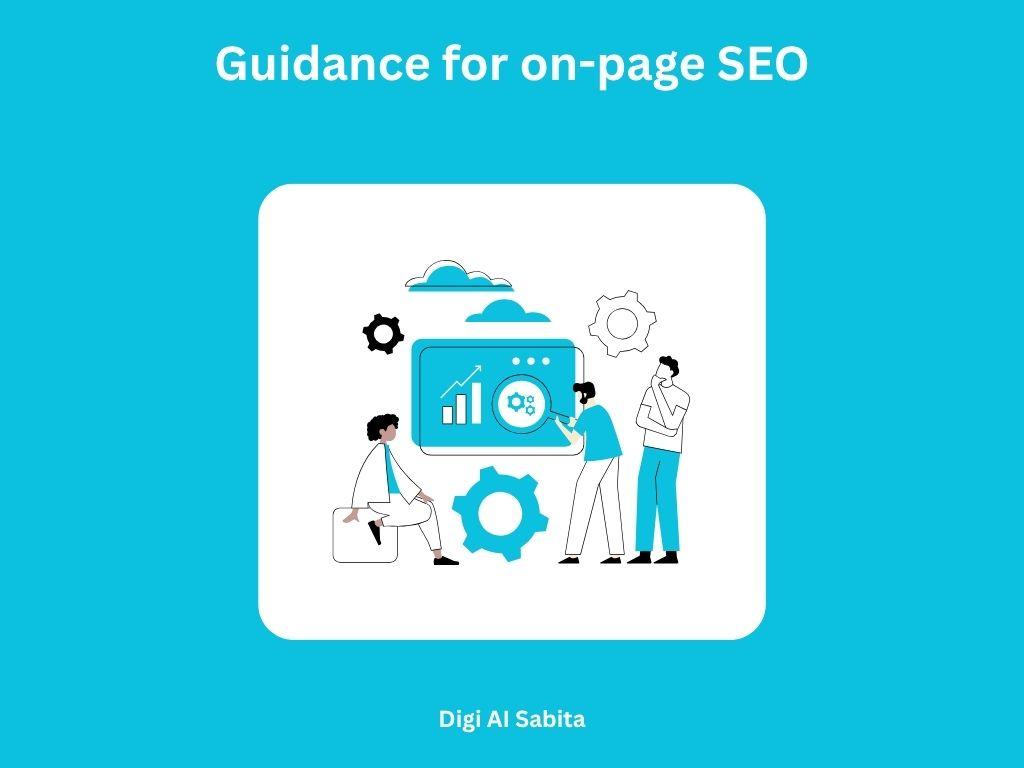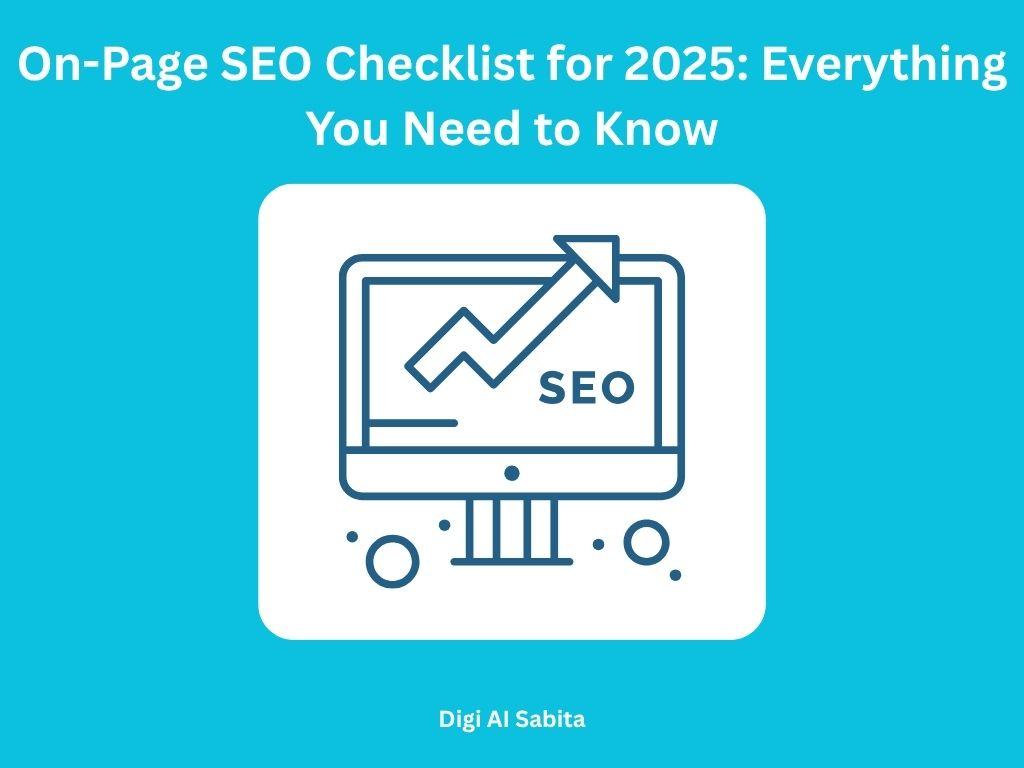Introduction: On-Page SEO in 2025
Nowadays, SEO isn’t just about utilizing the right keywords anymore; it’s about creating genuine content that engages users as well as search engines. On-page SEO has changed, and prioritizing user experience, search intent, AI-designed algorithms, and semantic content structure in 2025. Whether you are a blogger, business owner, or digital marketer, this final on-page SEO checklist will help you to optimize your site successfully.
- What is on-page SEO?
- Guidance for on-page SEO
- 1.Start with Keyword Research
- 2. Improve Title Tags for Relevance and Clicks
- 3. Write Attracting Meta Descriptions
- 4. Use Genuine Header Tags (H1, H2, H3…)
- 5. Focus on High-Quality, In-Depth Content
- 6. Image SEO Optimization
- 7. Enhance URL Structure
- 8. Optimize Internal Linking
- 9. Mobile-Friendly Design
- 10. Boost Page Speed & Core Web Vitals
- 11. Include Schema Markup
- 12. Attach Clear CTAs (Call-to-Actions)
- 13. Refresh and Revise Outdated Content
- 14. Optimize for Voice Search and AI Assistants
- 15. Optimize User Experience (UX)
- Conclusion
- FAQs:
- You may like:
What is on-page SEO?
It refers to the action of optimizing individual web pages to rank higher and receive more relevant traffic on search engines. The changes are made directly to the content and HTML source code.
Guidance for on-page SEO

1.Start with Keyword Research
Pre-write by deciding what your target audience is looking for. Target:
- Use the primary keyword: main phrase with a definite purpose.
- LSI Keywords: Latent Semantic Indexing words that confirm context.
- Select Long-Tail Keywords: Individual phrases with fewer competitors.
- Search Intent: Decide if customers seek information, to purchase something, or to compare.
Bonus Tip: Use search tools like Google Search Console, SEMrush, Ahrefs, and Google’s section to explore high-potential keywords.
2. Improve Title Tags for Relevance and Clicks
Your title tag should:
- Contain the main keyword close to the start.
- be within 50–60 characters.
- be attractive enough to get clicked.
- use power words such as “Checklist,” “Guide,” “Top,” “Easy.”
For example:
Bad: “Learn About SEO”
Good: “On-Page SEO Checklist for 2025: Boost Your Rankings Fast”
3. Write Attracting Meta Descriptions
Although meta descriptions don’t affect rankings directly, they affect CTR (click-through rate).
- It should be below 160 characters.
- Use the key keyword for targeting the emotional point.
- And mention the real content of the page.
For example:
“Search the whole 2025 on-page SEO checklist. Optimize content, rank higher, and drive traffic intelligently.”
4. Use Genuine Header Tags (H1, H2, H3…)
Headers improve content readability easily in sections and inform search engines about what your content contains.
- Use one H1 per page (the title).
- Organize H2s for subtopics and H3s for nested points.
- Include keywords naturally in headers.
5. Focus on High-Quality, In-Depth Content
In 2025, Google prioritizes content that completely and clearly answers user questions.
- Target length of 1,200–2,000 words for detailed coverage.
- Employ bullet points, bold, and images for flexibility.
- Address search intent (informational, transactional, etc.).
- Provide added value with statistics, examples, or FAQs.
6. Image SEO Optimization
Images increase user engagement and improve accessibility.
- Employ descriptive file names (e.g., on-page-seo-checklist.jpg).
- Adding descriptive ALT text with keywords.
- Reduce image file size to shorten loading time.
- Convert image to next-gen formats such as WebP.
7. Enhance URL Structure
Short, clean URLs with keywords are preferred.
Best practices:
- Don’t use dynamic URLs.
- Keep them below 60 characters.
- Use hyphens (–), not underscores (_).
Example:
example.com/on-page-seo-checklist-2025
8. Optimize Internal Linking
Planned internal linking aids:
- Increases crawlability.
- Transfers link equity.
- Directs users to related content.
Tips:
- Utilize keyword-dense anchor text.
- Link to cornerstone content and high-performing pages.
- Don’t overlink.
9. Mobile-Friendly Design
Google employs mobile-first indexing. Your website needs to be responsive.
- Always use mobile-friendly themes.
- Test with Google’s Mobile-Friendly Tool.
- Make text readable and buttons tappable on small screens.
10. Boost Page Speed & Core Web Vitals
Page speed is a ranking signal.
Optimize for:
- Largest Contentful Paint (LCP) less than 2.5 seconds.
- First Input Delay (FID) less than 100 ms.
- Cumulative Layout Shift (CLS) less than 0.1.
Tips:
- Utilize lazy loading for images.
- Minify CSS/JS.
- Improve hosting or use a CDN.
11. Include Schema Markup
Structured data aids search engine understanding of your content.
Common types are
- Article
- FAQ
- Review
- Product
- Local Business
Use Schema.org and Google’s Rich Results Test.
12. Attach Clear CTAs (Call-to-Actions)
Each page should move the user towards a target:
- Subscribe
- Contact
- Buy
- Read another article
Use buttons and compelling text to drive conversions.
13. Refresh and Revise Outdated Content
Search engines prefer new, fresh content.
- Continuously review and revise top pages.
- Repair old stats or broken links.
- Re-optimize keywords if SERPs have shifted.
14. Optimize for Voice Search and AI Assistants
Voice search is growing rapidly. Make content easily understandable:
- Provide specific answers (FAQs assist).
- Write in natural language.
- Provide featured snippet-type answers.
15. Optimize User Experience (UX)
Good content is wasted if users bounce.
Increase UX by:
- Keeping design consistent.
- Minimizing pop-ups.
- Offering easy navigation.
- Employing clear fonts and spacing.
Conclusion
On-page SEO in 2025 is not only about where you put keywords; it’s about providing value, enhancing usability, and responding to how search engines change. If you use this checklist, you’re not optimizing for Google; you’re making the web a better place for all your visitors.
Call to Action
Rank Higher in 2025? Begin Here!
Utilize this effective on-page SEO checklist to optimize your website for users and search engines, too.
Take action now, improve your visibility, and achieve results!
FAQs:
1. How is on-page SEO unique in 2025?
It is more centred on semantic search, user intent, AI algorithms, and Core Web Vitals than older tactics such as easy keyword stuffing.
2. How frequently should I refresh my SEO content?
You should update and review your content every 3–6 months to maintain freshness and conformance to the latest algorithms and trends.
3. Are meta tags still important in 2025?
Yes, particularly title tags and meta descriptions, they affect click-throughs and help search engines describe page relevance.
4. What are the examples of on-page SEO?
The examples are headings, subheadings, internal linking, and images with alt-text. These elements help content or blogs rank on search engines.
5. Do I need coding skills for on-page SEO?
You just need simple knowledge about HTML assists, but most CMS systems, such as WordPress, provide SEO plugins (such as Rank Math or Yoast) that enable non-coders.
